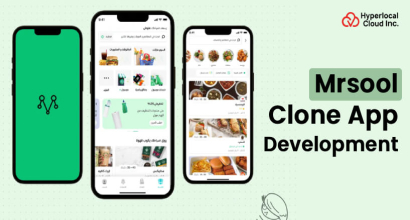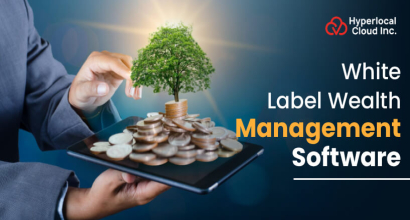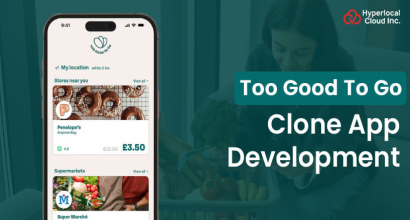The online clothing market has expanded rapidly in recent years. Several consumers are interested in buying and selling carefully used domestic products, goods, and costumes. A peer-to-peer marketplace that enables users to display, browse, communicate, purchase, and transport goods without the involvement of a traditional retailer is known as a Vinted clone.
It is anticipated that the global market for peer-to-peer apparel resale would expand dramatically each year. Eco-friendly and circular economy solutions are attracting more and more customers. They want to feel good about their purchases and reduce waste. An effective vinted clone software can capitalize on this expansion. It can provide a dependable community platform, excellent design, and the appropriate functionality.
What Is the Vinted App?
Vinted is an online e-commerce marketplace designed for the purchase and sale of custom-made clothes and goods. After registration, users create entries with details and images, determine a value, and activate the search. Customers can use filters such as space, size, brand, and position to browse through their options. Vinted app tracking numbers, printed labels, and in some fields, provides a shipment by offering options such as post-retrieval.
Want a Custom Vinted Clone?
How Does an App Like Vinted Work?
When you examine how an app like Vinted works, you see that it has several interconnected levels. Let's examine the process from onboarding until the completion of the transaction.
1. User Onboarding and Profiles
For the sake of simplicity, users first register by using an email address or a login from a social media platform. After that, users create a detailed profile, including their location, personal interests, images, and any other relevant information.
2. Item Listing Process
A user must take several pictures of their item to create a listing. They clearly state the brand, condition, size, and any defects in the title and description. They decide on a condition level, subcategory, and category. After that, they specify shipment options, such as courier delivery or local pickup.
3. Browsing and Searching
Customers can use the category, brand, price, size, and location filters to browse the catalog. They can also search using keywords. Listings are ranked by the platform so that comparable or similar items show up first. To receive notifications when new products are listed, buyers can follow vendors or add goods to their favorites.
4. Communication and Offers
A buyer can use an internal chat system to ask questions or submit an offer after viewing an item of interest. Relationships are developed during this negotiating process, which eventually results in an agreement.
5. Checkout and Payment
The buyer uses the platform's built-in payment gateway to make the purchase when both sides agree. Until the seller ships and the customer certifies receipt or the return window closes, payment remains in escrow.
6. Shipping and Delivery
Using the app, sellers can print a shipping label. They arrange a pickup or delivery of the item at a specified service space. Customers monitor delivery. The buyer verifies the item's position upon delivery, and the seller receives payment.
7. Ratings and Feedback
After delivery, customers and sellers evaluate each other based on communication, package quality, and detailed accuracy. Future users can choose reliable trading partners using these rankings, leading to the overall reputation ranking.
Explore the Key Features of Vinted Clone App
To create a ThredUp Clone or a Vinted Clone, you need to include some essential and advanced features and functionalities. Ensure that each feature fosters commitment and purpose. Some of the essential ones are mentioned below.
1. User Registration and Authentication
Permit users to register using social login platforms or their email addresses. Add verification techniques like phone or email verification. For extra security, use hashing to create secure passwords and think about using two-factor authentication.
2. User Profiles and Dashboards
Showcase your bio, location, listings, previous sales, earned money, reviews, and profile images on a dashboard. Items sold and awaiting payments should be shown to the sellers. Customers can monitor their likes and ongoing transactions. Profiles must be transparent and editable.
3. Listing Creation Tool
Create a listing that moves customers through the process of connecting images, composing details, determining the size and categories, setting prices, and selecting distribution options. Include tasks such as a comparable list, photo correction, and automatic knocking.
4. Browsing, Search, and Filters
Allow simple categories and subcategories to make browsing easy for users. The product position, size, color, location, shipping option, and price limit are examples of powerful filters. Allow customers to filter by the best match, price (from high to low), or the lowest price.
5. In‑App Chat and Negotiation
Provide a messaging platform that enables offers and item queries. Include unread message counts and notification alerts. Allow chat users to share images to request close-ups.
6. Offer/Price Negotiation
Allow buyers to suggest different prices. Display the original and offered pricing as well as the offer expiration date. Give vendors the option to accept, reject, or rebut the offer with a different price.
7. Payment Gateway and Escrow System
Include a secure payment system that holds the money in escrow until the buyer releases it after verifying the delivery has been made. Accept international payment methods, including PayPal, Stripe, Apple Pay, Google Pay, debit cards, and credit cards.
8. Shipping Integration
Collaborate with the GPS operating systems to offer real-time tracking and construction of shipping labels. Provide an alternative for picking up homes or nearby. In the app, you can view the tracking position and offer a cost calculator for shipments.
9. Reviews and Rating System
Both sides evaluate each other on factors including item accuracy, communication, shipment speed, and packaging following every transaction. On user profiles, show the total rating score and the most recent reviews.
10. Notification System
Construct email and push alerts for ratings, offers, chat messages, and shipment information. Provide users with the option to select which alerts they wish to receive.
11. Favorites and Following
Permit customers to follow vendors or save products. When sellers post new listings, users are notified. This promotes interaction and follow-up visits.
12. Admin Panel
Build a backend with dashboards to track user activity. Dispute resolution, moderation of reported users or content, fee and commission management, shipping rate updates, and viewing of performance statistics should all be possible with the use of these tools.
Unleash the Advanced Features of Vinted Clone
If you want the Vinted clone app to stand out, you need to include more refined features. These features provide a seamless user experience that enhances engagement and unlocks new revenue streams.
1. AI‑Powered Image Tagging
Identify the type of hats, color, brand logo, and potential fabric patterns with automatic artificial intelligence. This discovery can increase the relevance and accelerate list production. In addition, the consistent category tasks facilitate.
2. Smart Pricing Suggestions
Check comparable entries and previous sales. Provide recommended prices according to the popularity, brand, and position of the item. Provide sellers with up-to-date information to determine competitive prices.
3. Virtual Closet and Wardrobe Management
Let customers notice their favorite items that are not for sale, save previous purchases, or list items ready for sale in their carts. This user encourages commitment and storage.
4. Social Engagement Features
Give users the option to publicly share wishlists, leave comments on products, or create outfit inspiration boards by showcasing the things on the list. This encourages visitors to explore and interact for longer, providing a social element.
5. Shipping Insurance Options
Provide users with the option of insurance to protect against misplaced, fraudulent, or damaged goods during transit. As a result, more buyers and sellers are encouraged to list more expensive items on the marketplace.
6. Local Meet‑Up Arrangements
Offer customers the option of local pickup instead of shipping. The app can provide safety advice and assist with meeting scheduling. After pickup is confirmed in the app, an optional escrow release may also be included.
7. Loyalty Rewards and Referrals
Use referral bonuses, discount credits, or reward points to encourage usage. By inviting people or listing products, users can earn credits. You can utilize these credits to attract new customers or reduce delivery costs.
8. Cross‑Platform Support
Provide a top-oriented cross-platform or completely native experience online, iOS, and Android. It should be easy for users to transfer between equipment without problems.
9. AR Visual Try‑On
Allow customers to virtually try on clothes using augmented reality. This lowers returns and increases buyer confidence. Mobile cameras can also be used to preview accessories.
10. Analytics and Reporting Tools for Sellers
Provide sellers with key metrics, including average time to sale, watchlist activity, number of views, and price comparisons. This enables businesses to boost sales success and refine their listings.
Start Building Your Vinted-Like App Today
Steps to Create an App Like Vinted
Creating an app like Poshmark or Vinted requires several steps, some of which are outlined below. Let's go over each phase of the procedure.
1. Market Research and Business Planning
Identify your target groups first. Check the participants to determine your strengths and weaknesses. Choose your cash flow, which includes exclusively ads, listing fees, commissions, and subscription levels.
2. MVP Features
To validate market demand and get started quickly, consider launching a minimal viable product. Include key features such as escrow payment, list creation, browsing, chat, user registration, and shipping connections. To reduce development time and expenses, save refined technologies like AI and AR for later use.
3. UI UX Design
Build wireframes that indicate each user flow. Onboarding, listing, browsing, purchasing, and presenting reviews are some of these. Then, create high-quality mockups that accurately represent your brand. Priority for purpose, clarity, and simplicity.
4. Technology Stack
Select a technical stack tailored to the development team's infrastructure, budget, and skill level. Swift for iOS, Kotlin for Android, React or Angular for frontends, and Node.js or Python for backends are popular options. Choose a scalable database, such as MongoDB or PostgreSQL. To ensure availability, consider using AWS or Google Cloud for Skyhotell. For front-end and back-end communication, use GraphQL or a RESTful API.
5. Development and Integration
The development phase includes the expertise of both frontend and backend developers. Meanwhile, third-party integrations, such as AI integration, API integration, payment gateway integration, and social media integration, are a core part of the overall app development phase. However, the database and server-side logic are also essential components of a fitness mobile app development.
6. Quality Assurance and Testing
Develop comprehensive test plans that encompass acceptability, performance, integration, and continuous testing to ensure thorough evaluation of all aspects. Utilize real users during the alpha and beta testing stages. Obtain input and make adjustments while also closely monitoring backend performance. Manage service alerts, fallback notifications, and error logging.
7. Soft Launch and Monitoring
To collect real user data, start an MVP in a limited field. Track indicators such as average pricing, shipping activity, complete transactions, listed goods, chat interactions, and registrations. To track events, use programs such as Google Analytics or MixPanel. Get the user from the user. Regular users identify requirements and areas of friction. To improve the experience, quick repetition is key.
8. Post‑Launch Improvements
Include premium features like picture recognition, analytics dashboards, AR try-ons, virtual fits, subscription options, and creative pricing tools. Continue to make changes based on market trends and user data. Updating libraries and maintaining infrastructure will guarantee security and performance.
How to Monetize a Vinted Clone?
Utilizing a variety of monetization techniques is necessary to transform your Vinted clone into a profitable enterprise. Let's examine them in greater detail.
1. Commission on Each Sale
Add a 2% fee to each successful transaction. Ten to twenty per cent of the sale price, for instance, could be yours. This reduces user friction and matches your revenue with marketplace usage.
2. Listing Fees
Pay a nominal fee to vendors to publish their goods. As an alternative, provide free listings but charge a fee for extra benefits, such as premium placement, featuring, and refresh options.
3. Featured Listings and Ads
Give vendors the option to upgrade to have their products featured prominently on the homepage or at the top of search results. Additionally, you can let customers sponsor products they would like to have featured.
4. Subscription Plans
Offer a premium membership package with benefits like priority customer service, early access to new features, reduced listing costs, reduced commissions, or special delivery prices.
5. Shipping and Insurance Partnerships
Collaborate with shipping and insurance firms to generate income. For users, you can offer lower prices and charge a nominal fee for shipping or insurance.
6. In‑App Advertising
Include advertisements for eco-friendly products or stylish businesses. Ensure they are relevant and non-intrusive. Utilize natural ad formats, such as suggested items or sponsored collections.
7. Data Insights for Brands or Retailers
You can package reports or analytics dashboards for fashion brands if you have a large amount of anonymized data on item categories, prices, and sales patterns. They can use it to forecast demand, manage inventory, and predict resale trends.
8. Affiliate Marketing
Collaborate with companies that offer novel products. Showcase affiliate product placements or suggest related products to customers. You are paid when consumers click and make a purchase.
9. Virtual Gifts and App Rewards
During transactions, let customers send virtual presents or tip sellers with virtual currency. These can produce financial flow and promote involvement.
How much does it cost to create a Clothing app like Vinted?
The cost of developing a garment resale app, such as Vinted, varies based on the features, design, development team, and complexity of the app. The average price to create a Vinted clone is $5,000. By offering scalable solutions, reusable components, and post-launch support, an on-demand app development company can help startups or entrepreneurs reduce expenses.
The team's expertise, third-party integration, growth platform (iOS, Android, or both), and whether you choose a white label solution are the factors that may increase the overall development cost.
Turn Your Fashion Resale Idea into Reality
Why Partner with Hyperlocal Cloud Inc?
As a reliable software development company, Hyperlocal Cloud Inc. stands out for companies seeking to introduce cutting-edge, intuitive apps across various sectors, including fashion and second-hand markets. By collaborating with Hyperlocal Cloud Inc., you will have a dependable, creative, and knowledgeable supporter on your digital path.
Here's why clients choose us:
Expertise in Niche Platforms: Our field of expertise is developing unique solutions for markets, resale, and hyperlocal applications. We are aware of the dynamics of the fashion, food, and service industries.
End-to-End Services: Our team handles all stages of app development, including design, development, testing, distribution, and maintenance, from conception to launch and continuous support.
Agile & Scalable Solutions: Our scalable architecture enables your app to expand with your company, and our tightly integrated functions ensure timely delivery.
Client-Centric Approach: We put your vision first by providing open communication, teamwork in project planning, and committed assistance.
Affordable Pricing Models: We provide numerous price alternatives without sacrificing quality, regardless of your company's size.



